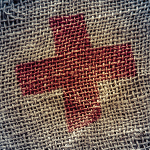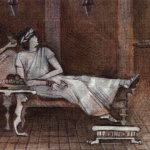Fortunately for Cushing and the world of medicine, he eventually fully recovered from this illness.
Life in the trenches was a miserable experience. Many, if not most, infantrymen suffered from low back pain or sciatica, whose relationship to disk impingement was unknown at the time. Some soldiers developed camptocormia, a bizarre posture characterized by an abnormal, severe and involuntary forward flexion of the thoracolumbar spine that became manifest during standing and walking and subsided in the recumbent position.8 Originally described as a psychogenic disorder or a form of malingering that was being used by some troops as a way to avoid military duty, it was later determined that these postures helped relieve their pain. Sadly, this insight may have come too late to save the lives of some soldiers who were court martialed and executed for dereliction of duty.
Through the ages, physicians have been at the warrior’s side, offering rudimentary forms of first aid medicine.
The Gas Attacks
In the Battle of Ypres, troops faced another unexpected lethal challenge—mustard gas. Released by the Germans to decimate their enemy, the use of poison gases significantly altered the dynamics of WWI, and all future wars. It also changed the course of medicine.
Early research studying the effects of mustard gas observed that it “attacked” leukocytes, but the major discoveries related to its potential medical uses came decades later during WWII. In 1943, an American cargo ship, the SS John Harvey, docked in the port of Bari, Italy, was attacked in an air raid and sank, along with its secret cargo of mustard gas bombs. More than a thousand people were exposed to the gas and nearly 80 died. Autopsies on the victims noted a consistent finding: profound bone marrow suppression. This information was passed along to two American pharmacologists, Louis Goodman, MD, and Alfred Gilman, MD, who were working for the U.S. Department of Defense exploring potential therapeutic applications of chemical warfare agents.
Drs. Goodman and Gilman had already converted the volatile mustard gas into the more stable nitrogen mustard by substituting a nitrogen molecule for sulfur. Based on the information provided to them, they surmised that nitrogen mustard might be useful in the treatment of lymphoma. Within months, this agent was given to the first cancer patient, whose tumor temporarily shrank. This seminal event marked the discovery of chemotherapy and immune suppression as viable cancer therapies.10 It was not long before our rheumatology forebears began administering cyclophosphamide, 6-mercaptopurine and methotrexate to their sick patients.
Where the Poppies Grow
As a medical student, I used to walk by a beautiful stained-glass window honoring Lt. Colonel John MacRae, MD. A pathologist by training, he volunteered for military service in WWI at age 42. Devoted to his troops, he remained on duty even after his tour was completed. He is best remembered for writing the most memorable poem of the Great War, the haunting, “In Flanders Fields.” Written during the Battle of Ypres, it is an unforgettable account of war and bloodshed, death and destruction. And one of hope and humanity.



